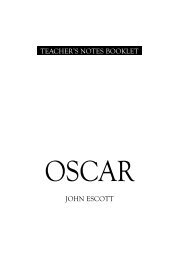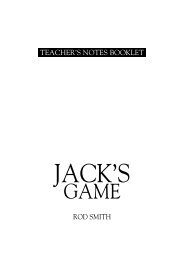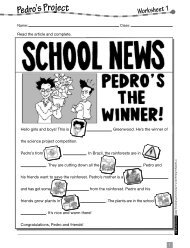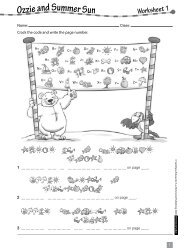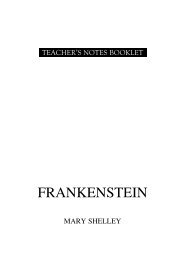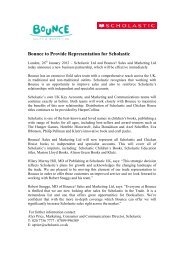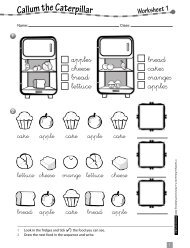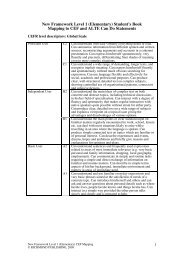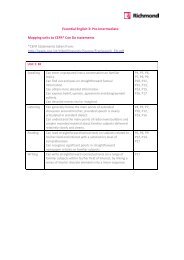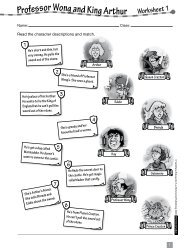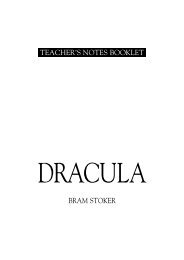Jason Causes Chaos - Supadu
Jason Causes Chaos - Supadu
Jason Causes Chaos - Supadu
Create successful ePaper yourself
Turn your PDF publications into a flip-book with our unique Google optimized e-Paper software.
TEACHER’S NOTES BOOKLET<br />
JASON CAUSES<br />
CHAOS<br />
JEREMY TAYLOR
CONTENTS<br />
Background information 3<br />
Activities before reading the story 4<br />
Activities while reading the story 4<br />
Activities after reading the story 6<br />
Extended writing 6<br />
Worksheets 7<br />
Key to Book Exercises 14<br />
GRADING SCHEME<br />
LEVEL ONE (500 headwords)<br />
present simple<br />
present continuous (present)<br />
going to (future)<br />
past simple<br />
imperative<br />
can (ability and permission)<br />
would like (requests and offers)<br />
must (obligation)<br />
let’s, shall (suggestions)<br />
gerunds<br />
adverbs (time, manner and place)<br />
adjectives (comparatives and superlatives)<br />
LEVEL TWO (800 headwords)<br />
all of the above, plus<br />
present continuous (future)<br />
going to (intentions)<br />
present perfect<br />
past continuous<br />
past perfect<br />
passive (simple forms)<br />
will/shall (future, requests and offers)<br />
must/can’t (deduction)<br />
have to (obligation)<br />
should (advice)<br />
gerund as subject<br />
too/enough + adjective<br />
reported speech (with ask/tell/say)<br />
zero and first conditional<br />
defining relative clauses<br />
LEVEL THREE (1200 headwords)<br />
all of the above, plus<br />
present perfect continuous<br />
passive (all tenses excluding modals)<br />
was/were going to<br />
used to<br />
make/let<br />
may/might (possibility)<br />
reported speech<br />
LEVEL FOUR (1800 headwords)<br />
all of the above, plus<br />
past perfect continuous<br />
future perfect<br />
future continuous<br />
passive (modals)<br />
had better/would rather<br />
second and third conditionals<br />
2
JASON CAUSES CHAOS<br />
BACKGROUND INFORMATION<br />
Babysitting<br />
It is common practice in the UK for a parent or<br />
parents to employ the services of a babysitter to look<br />
after the children when the parents are unable or<br />
unwilling to take the children out with them.<br />
Babysitters are often relatives, friends or neighbours,<br />
or people paid by the hour for their services. Many<br />
teenagers and students (usually female) do babysitting<br />
to earn extra money. There are several babysitting<br />
agencies in the UK where a small amount of the<br />
babysitter’s earnings are paid to the agency which<br />
interviews and assigns babysitters to clients.<br />
Advertisements<br />
Many shops, post offices, libraries and clubs allow<br />
people to put up advertisements for services, things<br />
for sale or items wanted in the windows or on their<br />
notice boards. Advertisements are usually written on<br />
blank postcards, index cards or business cards.<br />
Police<br />
A police officer with the rank of Police Constable is<br />
referred to as P.C. (surname).<br />
A Police Constable can be a woman or a man.<br />
Cellars<br />
Many old houses in the UK have cellars in the<br />
basement, which are generally used for storage. See<br />
the plan.<br />
Letter-boxes<br />
Most front doors of houses in the UK are fitted with<br />
flaps which can open for the delivery of letters and<br />
other papers. See the plan.<br />
3
JASON CAUSES CHAOS<br />
TO THE TEACHER<br />
Welcome to the Teacher’s Notes for the Richmond<br />
Reader, <strong>Jason</strong> <strong>Causes</strong> <strong>Chaos</strong>. Here you will find a<br />
wide variety of activities based on the story.<br />
Materials for the students are given on the<br />
worksheets on pages 7 - 13.<br />
There are seven worksheets and a page of activities<br />
for Extended Writing. Photocopy the worksheets as<br />
you need them for your students. Each activity in<br />
the Teacher’s Notes that uses a worksheet indicates<br />
which worksheet to use after its title.<br />
All the activities have suggestions for class management.<br />
They are all labelled as whole class, group, pair<br />
or individual tasks or a combination of these. You<br />
may want to assign the individual activities for<br />
homework, but make sure that the students know<br />
exactly what to do before they start. Some of the<br />
activity types may be new to them.<br />
In discussion activities, decide whether you want<br />
your students to use English or their own language.<br />
Activities before reading the story<br />
Do not give students the book yet.<br />
1 Prediction WS 1 Whole class, groups or pairs<br />
•<br />
Ask students to look at Activity 1 on Worksheet 1,<br />
and to make predictions about the story based on<br />
the realia, artwork and text in the activity.<br />
2 Discussion No WS Whole class, groups or pairs<br />
•<br />
Ask students to suggest jobs they could do to<br />
earn extra pocket money. Ask if anyone has a<br />
Saturday or evening job, e.g. working in a shop,<br />
supermarket, delivering newspapers or groceries,<br />
cleaning or shopping for people, etc. (These are<br />
jobs frequently done by students in the UK.)<br />
Ask if anyone has ever done any babysitting.<br />
What were the children like? What were the<br />
parents like? Were the children well-behaved?<br />
Ask students what they would do if they found<br />
themselves having to babysit a badly-behaved<br />
child.<br />
Activities while reading the story<br />
3 Check the time WS 2 Pairs or individual<br />
•<br />
until the end.<br />
•<br />
Start at the beginning of the story, and continue<br />
Draw students’ attention to the fact that Eva<br />
is very conscious of the time - she looks at her<br />
watch often, wishing the minutes would pass<br />
quickly. Ask students to use the blank clock face<br />
to make a note of each time Eva checks her<br />
watch. Suggest to students that they use a<br />
different colour for each time. Students should<br />
note the time, and what Eva and <strong>Jason</strong> are doing<br />
around that time, as in the example.<br />
4 Tick the rules WS 3 Individual<br />
•<br />
Set this task after reading chapter 3.<br />
Tell students to read the list of (true and false)<br />
‘house rules’ written by Mrs Day. They should<br />
tick the three rules that are true.<br />
Answers: Numbers 1, 3 and 5 are true.<br />
5 Write Eva’s diary WS 3 Individual<br />
•<br />
end of each chapter.<br />
•<br />
Start after reading Chapter 4, then repeat at the<br />
Ask students to read Eva’s first entry in her diary,<br />
written after she met <strong>Jason</strong> for the first time. Tell<br />
students to imagine that they are Eva. At the end<br />
of each chapter, they should write down a<br />
paragraph summarising Eva’s thoughts about the<br />
events in each chapter. (In this way, students are<br />
producing an ongoing summary of the main<br />
events in the story.)<br />
4
JASON CAUSES CHAOS<br />
6 List the ‘lies’ in the story No WS<br />
Individual or whole class<br />
• Start after reading Chapter 4, and continue until<br />
the end.<br />
• Ask students to keep a record in their notebooks<br />
of all the ‘lies’ that are told in the story.<br />
•<br />
Set aside a few minutes after reading each chapter<br />
for students to think about and note down any<br />
lies that were told in that chapter.<br />
Answers<br />
‘We were upstairs,’ said <strong>Jason</strong>. ‘I was showing<br />
Eva my new computer game. It’s very loud.’<br />
(page 20)<br />
‘Didn’t you know? There’s a little man who lives<br />
in the pipes under every bath. He drinks bath<br />
water.’ (page 24)<br />
‘<strong>Jason</strong> had a bath and then went to bed at half<br />
past nine.’ ‘Well, maybe it was twenty five to<br />
ten, but he’s asleep now.’ (page 29)<br />
‘I’m watching a film about pirates.’ (page 30)<br />
‘Come in, P.C. Thomson. Sorry, I had a problem<br />
with the door.’ (page 37)<br />
‘Sometimes people come in and talk to us about<br />
their jobs.’ (page 38)*<br />
‘Colin brought them here. Eva’s boyfriend. Colin<br />
came to our house. They sent me upstairs, but I<br />
watched them. Do you know what they were<br />
doing on the sofa? First of all they kissed...’<br />
(page 45)<br />
* possibly a lie<br />
7 Crossword WS 4 Individual<br />
•<br />
Set this task after reading Chapter 9.<br />
Answers<br />
Across: 2 pirates 3 pockets 4 babysitter<br />
6 plug-hole 9 detective 10 parents<br />
Down: 1 biology 4 boss 5 salads 7 litre 8 taps<br />
8 True or false? WS 4 Individual or pairs<br />
Set this task after reading Chapter 9.<br />
•<br />
Ask students to say whether the sentences are<br />
true (T) or false (F).<br />
Answers<br />
1 T 2 T 3 F 4 F 5 F 6 F 7 T 8 F 9 T<br />
10 F<br />
9 Correct the summary WS 5 Individual or<br />
pairs<br />
Set this task after reading Chapter 12.<br />
•<br />
Ask students to read the summary of Chapters<br />
10 - 12. The summary contains 10 errors. Ask<br />
students to find and correct these errors.<br />
Answers (in italics)<br />
<strong>Jason</strong> and Eva saw a man at the side of the<br />
garden. Then he stood under the window. Eva<br />
picked up a heavy flower pot and threw it on the<br />
man’s head. <strong>Jason</strong> and Eva ran downstairs. Eva<br />
started to dial 999 to call the police. <strong>Jason</strong> stopped<br />
her. The man lying in the garden was a policeman.<br />
The policeman came in and Eva gave him<br />
a cup of tea. She put a bandage on his head. Eva<br />
invited him to come to her school to talk about<br />
his job. He wrote down the date in his diary.<br />
The name on the diary was P.C. J Thomson.<br />
Then he left. Later, <strong>Jason</strong> and Eva saw another<br />
man in the garden. He looked exactly the same as<br />
P.C. J Thomson. The man rang the doorbell. He<br />
wanted to phone the police station. Eva asked for<br />
his identity card. The name on the card was<br />
P.C.J Thomson. Eva and <strong>Jason</strong> thought the man<br />
at the door was the escaped prisoner. Perhaps he<br />
had attacked P.C. Thomson, put on his uniform<br />
and taken his identity card. They invited the man<br />
in and noticed that he had P.C. J Thomson’s<br />
diary too. Eva hit him on the head with a<br />
saucepan. They pulled him into the cellar and shut<br />
the door.<br />
10 Order the events WS 5 Individual or pairs<br />
Set this task after reading Chapter 13.<br />
•<br />
The sentences about the events in Chapters 4 - 13<br />
are in the wrong order. Ask students to put the<br />
sentences in the correct order.<br />
Answers<br />
The correct order is 5, 12, 9, 7, 11, 3, 6, 1, 10, 4,<br />
2, 8.<br />
5
JASON CAUSES CHAOS<br />
Activities after reading the story<br />
11 Tick the adjectives WS 6 Pairs<br />
•<br />
Tell students to choose two adjectives which best<br />
describe the characters.<br />
Answers<br />
<strong>Jason</strong>: disobedient, arrogant<br />
Mrs Day: hysterical, emotional<br />
Mr Day: calm, friendly<br />
Eva: patient, responsible<br />
12 What are their thoughts? WS 6<br />
Individual, pairs or groups<br />
• Tell students to read the thought bubbles. Who<br />
does each one belong to? Students should then<br />
match each thought bubble to one of the pictures<br />
in the story.<br />
•<br />
Encourage them to think of different thought<br />
bubbles which could correspond to the pictures,<br />
if you like.<br />
‘I don’t want to go!’ (page 7)<br />
‘Another stupid girl...’ (page 12)<br />
‘What a horrible pet!’ (page 15)<br />
‘I can’t believe he’s going to eat all ten of them!’<br />
(page 18)<br />
‘He’s been in there for nearly an hour.’ (page 23)<br />
‘He didn’t turn the taps off!’ (page 28)<br />
‘Ouch! What has happened to my head?’<br />
(page 32)<br />
‘I’ll tell her school friends to be careful with<br />
flower pots!’ (page 35)<br />
‘This is hard work...’ (page 39)<br />
‘What is my brother doing in the cellar?’<br />
(page 42)<br />
Extended Writing<br />
Activity 1<br />
• Ask your students to read the conversation<br />
between Eva and her friend Sonja on page 8<br />
again. Can they guess what Sonja is saying? Ask<br />
them to write Sonja’s side of the conversation.<br />
Activity 2<br />
• Ask your students what they think happened<br />
after <strong>Jason</strong> told his parents the lie about Eva’s<br />
boyfriend? Ask them to work in groups of four<br />
and plan the conversation between Eva, <strong>Jason</strong><br />
and his parents. They should decide on which<br />
roles to take, then work together and write the<br />
conversation. Encourage them to practise the<br />
conversation and act it out for their classmates.<br />
Activity 3<br />
• Ask your students to imagine that they would<br />
like to earn some extra pocket money. They can<br />
write an advertisement for themselves to put up<br />
in a shop window. Encourage them to look at<br />
Eva’s note on Worksheet 1 again and use it as<br />
a model.<br />
13 Complete the newspaper report WS 7<br />
Individual<br />
• Ask students to read and complete the newspaper<br />
report about Eva and the Thomson twins.<br />
Answers<br />
1 fifteen 2 seven 3 newspaper<br />
4 park 5 dinner dance 6 prisoner 7 shops<br />
8 chocolate 9 boyfriend 10 garden<br />
11 flower pot 12 uniform 13 helmet<br />
14 identification 15 Heavy 16 attacked<br />
17 diary 18 saucepan 19 cellar 20 twin<br />
6
WORKSHEET 1<br />
JASON CAUSES CHAOS<br />
Do this activity before you read the story.<br />
ACTIVITY 1 Prediction<br />
Look at the text and pictures below. What do they<br />
tell you about the story you are going to read? Who<br />
are the main characters? How do they meet each<br />
other? What can you guess about their characters?<br />
Discuss these questions with your classmates or<br />
partner.<br />
Prisoner<br />
escapes<br />
‘He’s not a monster,’ said Mrs Day. ‘Are you, <strong>Jason</strong>?’<br />
There is no Activity 2 on the worksheet.<br />
7
JASON CAUSES CHAOS<br />
WORKSHEET 2<br />
Do this activity while you are reading the story.<br />
ACTIVITY 3 Check the time<br />
Start at the beginning of the story and continue until the end.<br />
Eva often looks at her watch because she wants the minutes to pass quickly. Use the blank clock face below to<br />
make a note of each time Eva checks her watch. Note the time and what Eva and <strong>Jason</strong> are doing around that<br />
time, as in the example. For clarity, use a different colour for each time you mark on the clock.<br />
12<br />
9 3<br />
6<br />
twenty five to seven<br />
<strong>Jason</strong>’s parents drive away<br />
Eva reads in the living room<br />
<strong>Jason</strong> is in the kitchen, eating ice-cream<br />
8
WORKSHEET 3<br />
JASON CAUSES CHAOS<br />
Do these activities after the chapters given.<br />
ACTIVITY 4 Tick the rules<br />
Do this activity after reading Chapter 3.<br />
Read the list of true and false ‘house rules’ written by<br />
Mrs Day. Tick the three rules that are true.<br />
1 Don’t put too much water in the bath.<br />
2 Have a bath before you have dinner.<br />
3 Don’t eat too much ice-cream.<br />
4 Don’t watch too many videos.<br />
5 Don’t go out at night.<br />
6 Go to bed at half past nine every night.<br />
ACTIVITY 5 Write Eva’s diary<br />
Start after reading Chapter 4, then repeat the activity<br />
after each chapter, until the end.<br />
Read Eva’s diary. She wrote this just after she met<br />
<strong>Jason</strong> for the first time. Now imagine that you are Eva.<br />
After each chapter, write a paragraph summarising<br />
Eva’s thoughts in her diary.<br />
There is no Activity 6 on the worksheet.<br />
9
JASON CAUSES CHAOS<br />
WORKSHEET 4<br />
Do these activities after reading Chapter 9.<br />
ACTIVITY 7 Crossword<br />
Clues:<br />
Across<br />
2 After his bath, <strong>Jason</strong> watched a film about ___ on<br />
TV.<br />
3 <strong>Jason</strong> put 9 Bonga Wongas into the ___ of his<br />
coat.<br />
4 Eva wanted to earn extra money as a ___.<br />
6 <strong>Jason</strong> looked down the ___ of the bath to see the<br />
little man living under the bath<br />
9 Before his bath, <strong>Jason</strong> watched a ___ film on TV.<br />
10 <strong>Jason</strong>’s ___ were at a dinner dance.<br />
Down<br />
1 ___ is the study of plants and animals.<br />
4 <strong>Jason</strong> and Eva both thought they were the ___.<br />
5 <strong>Jason</strong> doesn’t like ___, but he likes chocolate.<br />
7 There was a 4-___ carton of ice-cream in the<br />
fridge.<br />
8 <strong>Jason</strong> left both ___ on in the bathroom. 1<br />
ACTIVITY 8 True or False?<br />
Read the sentences and say whether they are true (T)<br />
or false (F).<br />
1 <strong>Jason</strong> and Eva both like chocolate.<br />
2 <strong>Jason</strong>’s last babysitter was Eva’s friend, Sonja.<br />
3 Chief Inspector Ian Catcham was a friend of Mrs<br />
Day’s.<br />
4 <strong>Jason</strong> took money out of Eva’s bag.<br />
5 <strong>Jason</strong> showed Eva his new computer game.<br />
6 Eva’s boyfriend is called Colin.<br />
7 <strong>Jason</strong> doesn’t think Eva is very intelligent.<br />
8 Eva didn’t hear the phone ringing, because <strong>Jason</strong><br />
was watching TV.<br />
9 Eva and <strong>Jason</strong> found Bonga Wongas in the fourth<br />
shop they went to.<br />
10 <strong>Jason</strong> stayed in the bath for an hour.<br />
2<br />
3<br />
4 5<br />
6 7<br />
8 9<br />
10<br />
10
WORKSHEET 5<br />
JASON CAUSES CHAOS<br />
Do these activities after the chapters given.<br />
ACTIVITY 9 Correct the summary<br />
Do this activity after reading Chapter 12.<br />
Read the summary of Chapters 10 - 12. The summary<br />
contains 10 errors. Find and correct these errors, as in<br />
the example.<br />
<strong>Jason</strong> and Eva saw a man at the side of the<br />
garden. Then he stood under the tree. Eva<br />
picked up a heavy vase and threw it on the<br />
man’s head. <strong>Jason</strong> and Eva ran downstairs. Eva<br />
started to dial 333 to call her mother. <strong>Jason</strong><br />
stopped her. The man lying in the garden was a<br />
policeman. The policeman came in and Eva gave<br />
him a cup of coffee. She put a bandage on his<br />
head. Eva invited him to come to her house to<br />
talk about his job. He wrote down the date in<br />
his diary. The name on the diary was P.C. J<br />
Thomson. Then he left. Later, <strong>Jason</strong> and Eva<br />
saw another man in the street. He looked exactly<br />
the same as P.C. J Thomson. The man rang the<br />
doorbell. He wanted to phone the police station.<br />
Eva asked for his identity card. The name on the<br />
card was P.C. J Thomson. Eva and <strong>Jason</strong><br />
thought the man at the door was the escaped<br />
prisoner. Perhaps he had attacked P.C. Thomson,<br />
put on his uniform and taken his money. They<br />
invited the man in and noticed that he had<br />
P.C. J Thomson’s diary too. Eva hit him<br />
on the head with a book. They pulled him<br />
into the kitchen and shut the door.<br />
ACTIVITY 10 Order the events<br />
Do this activity after reading Chapter 13.<br />
The sentences about the events in Chapters 4 - 13<br />
are in the wrong order. Put the sentences in the<br />
correct order.<br />
1 Eva asks for the policeman’s identity card.<br />
2 The policeman tells Eva that the escaped prisoner<br />
has been caught.<br />
3 <strong>Jason</strong> has a bath.<br />
4 Eva and <strong>Jason</strong> pull the policeman into the cellar.<br />
5 <strong>Jason</strong> eats a litre of ice-cream.<br />
6 Eva throws a flower pot on the policeman’s head.<br />
7 Mrs Day phones <strong>Jason</strong> and Eva, but there is no<br />
answer.<br />
8 The two policemen tell Eva and <strong>Jason</strong> that they<br />
are twin brothers.<br />
9 <strong>Jason</strong> and Eva go to the shops to buy Bonga<br />
Wongas.<br />
10 Eva hits the policeman on the head with a<br />
saucepan.<br />
11 Mrs Day comes home to see if <strong>Jason</strong> is safe.<br />
12 <strong>Jason</strong> puts his pet rat on Eva’s shoulder.<br />
11
JASON CAUSES CHAOS<br />
WORKSHEET 6<br />
Do these activities after reading the story.<br />
ACTIVITY 11 Tick the adjectives<br />
Choose two adjectives from each group which best<br />
describe the characters. Then discuss your choices<br />
with a partner.<br />
<strong>Jason</strong>: kind, disobedient, arrogant, angry<br />
Mrs Day: hysterical, calm, emotional, beautiful<br />
Mr Day: interesting, calm, friendly, formal<br />
Eva: generous, stupid, patient, responsible<br />
ACTIVITY 12 What are their thoughts?<br />
Read the thought bubbles. Who does each one<br />
belong to? Then look at all the pictures in the story<br />
again. Match each thought bubble to one of the<br />
pictures. Check your answers with your classmates or<br />
a partner.<br />
I’ll tell her school friends to be<br />
careful with flower pots!<br />
I don’t want to<br />
go!<br />
He’s been in there for an<br />
hour already.<br />
Ouch! What has happened<br />
to my head?<br />
This is hard work...<br />
Another stupid<br />
girl...<br />
What is my brother<br />
doing in the cellar?<br />
He didn’t turn the<br />
taps off!<br />
What a horrible pet!<br />
I can’t believe he’s<br />
going to eat all ten of<br />
them!<br />
12
WORKSHEET 7<br />
JASON CAUSES CHAOS<br />
Do this activity after reading the story.<br />
ACTIVITY 13 Complete the newspaper report<br />
Read and complete the newspaper report about Eva and the Thomson twins.<br />
Schoolgirl gets the wrong man - twice!<br />
A (1)___-year-old schoolgirl, Eva Dean, had an<br />
embarrassing experience yesterday. Eva was<br />
babysitting for <strong>Jason</strong> Day, the (2) ___-year-old<br />
son of Mr Lee Day, the editor of the local (3)<br />
___, and Mrs Rosemary Day, at their home,<br />
The Lodge, next to the (4) ___ in Waterbridge.<br />
‘How did you know it was a policeman, Eva?’<br />
‘Well, he was wearing a blue (12) ___ and<br />
black shoes and his blue policeman’s<br />
(13) ___ was lying next to him. The flower pot<br />
knocked it off his head...’<br />
We spoke to Eva about the events of last night.<br />
Mr and Mrs Day were at a (5)___ ___ in New<br />
Wellington. Mrs Day telephoned her son from<br />
the dinner dance, but there was no answer. She<br />
was nervous. Where were her son and the<br />
babysitter? She told them they were not<br />
allowed to go out. Just then, Chief Inspector<br />
Ian Catcham told the Days about the (6) ___,<br />
Mr Heavy, who escaped from Waterbridge<br />
Prison yesterday afternoon. Mrs Day rushed<br />
home to see if <strong>Jason</strong> was safe. She saw that he<br />
was safe, and returned to the dinner dance.<br />
‘Eva, why didn’t you answer the telephone?’<br />
‘I was at the (7) ___, with <strong>Jason</strong>. He wanted me<br />
to buy him Bonga Wongas.’<br />
‘Bonga Wongas? What are they?’<br />
‘They are a kind of (8) ___ .’<br />
‘Why did you listen to <strong>Jason</strong>? His mother told<br />
you not to go out, didn’t she?’<br />
‘Yes, but <strong>Jason</strong> started practising a lie to tell his<br />
parents: Eva’s (9) ___ came to our house. I<br />
knew they would believe <strong>Jason</strong>. So I went to<br />
buy him the Bonga Wongas.’<br />
Eva then invited the policeman in and made<br />
him some tea.<br />
Later, Eva and <strong>Jason</strong> saw another policeman in<br />
the garden. He looked exactly the same as<br />
P.C. J Thomson. He rang the doorbell and Eva<br />
checked his (14) ___. She was sure it was the<br />
escaped prisoner, Mr (15)___.<br />
‘Eva, why did you think it was the escaped<br />
prisoner?’<br />
‘Because his identity card had the name P.C. J<br />
Thomson on it and the photo was the same too.<br />
I thought he had (16) ___ P.C. J Thomson, put<br />
his uniform on and taken his identity card.’<br />
‘What did you do then?’<br />
‘We opened the door and showed him the<br />
phone. He wanted to phone the police station.<br />
Then we saw his (17) ___. It was the same as<br />
P.C. J Thomson’s, and it even had his name on<br />
it. So we were sure it was Heavy, this time.’<br />
Eva hit the policeman on the head with a (18)<br />
___, and <strong>Jason</strong> helped her to pull him into the<br />
(19) ___. <strong>Jason</strong> saw another policeman coming<br />
to the house. It was P.C. J Thomson!<br />
At about 11 o’clock, <strong>Jason</strong> and Eva saw a man<br />
in the (10) ___. Eva thought it was the escaped<br />
prisoner. So she threw a (11) ___ ___ on his<br />
head. But it was a policeman - P.C. J Thomson.<br />
He told Eva and <strong>Jason</strong> that Mr Heavy had been<br />
caught. Eva was confused. She took P.C. J<br />
Thomson to the cellar and opened the door.<br />
P.C. J Thomson was surprised to see his<br />
(20) ___ brother Jeff in there!<br />
13
JASON CAUSES CHAOS<br />
KEY TO BOOK EXERCISES<br />
A<br />
Comprehension<br />
1 1 She wanted to go to the cinema with her<br />
friend Sonja.<br />
2 Sonja said that she had also been a babysitter<br />
for <strong>Jason</strong> Day and that he was a very naughty<br />
child.<br />
3 <strong>Jason</strong> ate too much ice-cream (and was<br />
probably ill) and put too much water in the bath<br />
(and probably caused a flood).<br />
4 <strong>Jason</strong> had eaten the rest.<br />
5 He will tell them that Eva’s boyfriend came to<br />
the house, and that Eva and her boyfriend sent<br />
<strong>Jason</strong> upstairs and started kissing on the sofa.<br />
6 They were at the shops and arrived home too<br />
late to pick up the phone.<br />
7 They lived in Waterbridge, near the park,<br />
and the prisoner might be hiding there.<br />
8 She will tell them that he took money from<br />
her bag.<br />
9 She told him that there was a little man living<br />
under the bath who wanted to drink the bath<br />
water because he was thirsty. He would die if he<br />
didn’t get water soon.<br />
10 He wanted to give the little man some water.<br />
2 1 L 2 T 3 L 4 T 5 L<br />
B<br />
Working with Language<br />
1 a 5 b 6 c 8 d 2 e 10 f 3<br />
g 7 h 1 i 9 j 4<br />
2 a so b before c or d but e then<br />
14
JASON CAUSES CHAOS<br />
THE RICHMOND READERS SERIES<br />
The Richmond Readers Series presents a selection<br />
of high quality, original and simplified stories which<br />
have been graded in four levels, from beginner to<br />
upper-intermediate. Our grading scheme has been<br />
devised with reference to the Council of Europe’s<br />
Waystage and Threshold syllabi and the Cobuild lists<br />
of the most frequently occurring words in the<br />
English language. Structures and vocabulary have<br />
been selected according to two criteria:<br />
1 what students are likely to have been taught<br />
2 what students will be able to deduce through<br />
transference from their own language<br />
Each Reader has a glossary and a number of different<br />
exercises to check comprehension and practise<br />
language manipulation.<br />
The Teacher’s Notes Booklets are a unique feature<br />
of the Richmond Readers Series. Each reader has<br />
an accompanying booklet with photocopiable<br />
worksheets, background notes for the teacher<br />
and ideas for additional activities, discussion work<br />
and project material.<br />
Richmond Readers offer the student<br />
Well-written stories in a variety of styles which<br />
guarantee an enjoyable reading experience.<br />
Language which is carefully graded to ensure that<br />
the Readers will be within the appropriate language<br />
level.<br />
Background information, glossaries and<br />
comprehension exercises to encourage student<br />
autonomy.<br />
Richmond Readers offer the teacher<br />
A broad selection of genres which will appeal<br />
to a wide variety of students.<br />
Support for the teacher, with a large number<br />
of additional activities and projects provided<br />
in the Teacher’s Notes.<br />
Richmond<br />
PUBLISHING<br />
Richmond Publishing<br />
58 St Aldates<br />
Oxford OX1 1ST<br />
United Kingdom<br />
© Richmond Publishing 1997<br />
First published 1997<br />
Revised: 2010<br />
EAN: 8431300108042<br />
All rights reserved.<br />
No part of this work may be reproduced, stored in a retrieval system or<br />
transmitted in any form, electronic, mechanical, photocopying or otherwise<br />
without the prior permission in writing of the copyright holders. Any<br />
infraction of the rights mentioned would be considered a violation of<br />
the intellectual property (Article 270 of the Penal Code). If you need to<br />
photocopy or scan any fragment of this work, contact CEDRO (Centro<br />
Español de Derechos Reprográficos, www.cedro.org).<br />
However, the publisher grants permission for the photocopying of those<br />
pages marked ‘photocopiable’, for individual use or for use in classes taught<br />
by the purchaser only. Under no circumstances may any part of this book<br />
be photocopied for resale.<br />
Design: Giles Davies Design<br />
Illustrations: Kathy Baxendale, Geo Parkin



